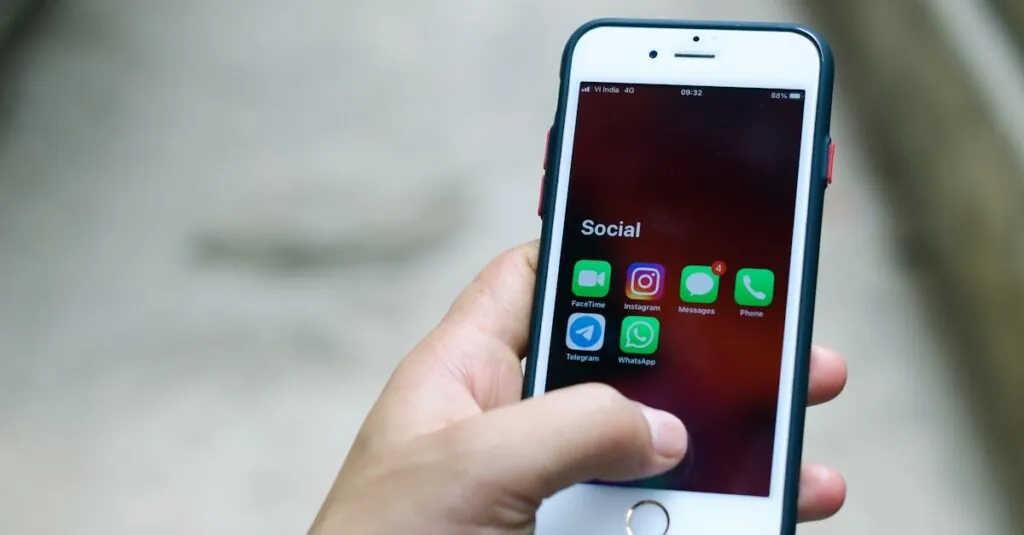Ever found yourself in a digital pickle, frantically searching for that one text you accidentally deleted? You’re not alone. Many iPhone users have experienced the frustration of trying to retrieve messages that seem to have vanished into thin air. It’s like playing hide and seek with your own phone, and let’s be honest—your iPhone is winning.
Table of Contents
ToggleUnderstanding Message Deletion on iPhone
Retrieving deleted messages on an iPhone presents numerous challenges. Users may expect deleted texts to remain visible in certain locations, but iOS operates differently. Deletion often triggers immediate removal from the device, rendering messages unrecoverable through normal means.
iPhones utilize an architecture that prioritizes storage efficiency. When a message is deleted, the storage space used becomes marked as available. This management technique prevents unauthorized access to potentially sensitive information. Users should understand that deleted messages don’t go to a recycle bin or temporary folder as seen in other systems.
Backup options play a crucial role in message recovery. iCloud and iTunes backups can be lifesavers for messages unintentionally lost. Regular backups create points in time where messages are preserved, allowing users to restore their device to a prior state. Searching through backups may uncover previously deleted texts that still exist.
Third-party recovery tools offer another avenue for potential recovery. Many of these applications can scan iPhone storage in search of deleted texts. However, results vary widely in effectiveness and reliability. Users must research and choose reputable tools to avoid data loss or further complications.
Recovery limitations also exist. Once a message is deleted and overwritten, it becomes nearly impossible to retrieve. Users who frequently delete and add new messages increase the likelihood of overwriting crucial data.
Understanding these aspects can help users navigate the complexities of message deletion on an iPhone. By implementing backup strategies and familiarizing themselves with recovery options, they can mitigate the frustration of lost texts.
Reasons for Unable to See Deleted Messages
Users often struggle to find deleted messages due to several factors related to iPhone functionality and settings.
iCloud and Backup Settings
iCloud settings determine what data gets stored and backed up. If iCloud Backup is disabled, messages aren’t saved, leading to permanent loss once deleted. Backups created through iTunes may store messages, but the most recent backup dictates what data can be restored. Without a recent backup containing desired messages, recovery options become limited. Users must regularly enable iCloud backups for automatic preservation of messages. Monitoring backup settings ensures text messages get preserved, reducing the likelihood of losing important communications.
Message App Functionality
The Message app operates on a system that doesn’t provide a simple way to recover deleted texts. When a message gets deleted, it’s no longer visible in the app, contributing to users’ difficulties in locating lost communications. The absence of a recycle bin means once users delete a message, it’s marked for overwriting, complicating recovery efforts. Users often find that existing messages can’t restore deleted ones without proper backup procedures. Understanding how the Message app manages data helps users make informed decisions to minimize data loss.
Methods to Retrieve Deleted Messages
Retrieving deleted messages on an iPhone involves specific methods. Users can explore iCloud recovery options and third-party apps to increase their chances of recovery.
iCloud Recovery Options
iCloud offers a viable path for message recovery. If iCloud Backup has been enabled, messages might be recoverable by restoring the device to a previous backup date. To initiate this, users should go to Settings, select the user’s name, tap iCloud, then choose Manage Storage. Here, they can check the backup dates and relevant data included. It’s essential to understand that any new data created after the backup date may be lost during the restore process. Users need to ensure that they back up important messages regularly to avoid data loss in the future.
Third-Party Apps
Various third-party apps can assist in recovering deleted messages. Many of these tools are designed to scan the iPhone’s storage for remnants of lost texts. Options like Dr.Fone, PhoneRescue, and EaseUS MobiSaver can help restore messages not saved in backups. Each app operates differently, with some offering a preview of recoverable messages before purchase. Users must read reviews and ensure compatibility with their iOS versions. Caution is important since recovery success can vary widely between applications, and effectiveness may depend on data overwriting instances.
Preventative Measures for Future Deletions
Regularly enabling iCloud Backup minimizes the risk of losing important messages. This feature saves recent data, allowing users to restore their iPhones to previous states. Utilizing iTunes for backups offers another layer of protection, ensuring that messages are stored on a computer.
Scheduling consistent backups establishes a safety net for communications. Users could set reminders to check backup settings every month. Activating automatic backups provides peace of mind, ensuring that no messages are left unprotected.
Additionally, exploring third-party backup solutions may bolster preservation efforts. Various applications can facilitate the archiving of messages, making recovery more accessible. Users should choose reputable options that align with their iOS version.
Maintaining organization within the Messages app can help users manage their communications better. Deleting unnecessary conversations regularly keeps the app tidy. Archiving important discussions can further safeguard essential information.
Educating oneself about message settings enhances recovery efforts. Understanding how message storage works on an iPhone aids in avoiding accidental deletions. Knowledge of recovery options empowers users to act quickly if situations arise.
Considering these preventative measures equips users to handle potential message loss better. Reviewing backed-up data regularly keeps records up to date. By implementing these strategies, users strengthen their defenses against the frustration of losing important texts.
Recovering deleted messages on an iPhone can feel like an uphill battle. The absence of a recycle bin and the way the device manages storage complicate retrieval efforts. Users must rely on backups and third-party tools to increase their chances of recovery.
To avoid future frustrations, it’s essential to prioritize regular backups through iCloud or iTunes. Being proactive in managing message settings and understanding recovery options can make a significant difference. By taking these steps, users can safeguard their valuable communications and minimize the chances of permanent loss.



